Double Prints
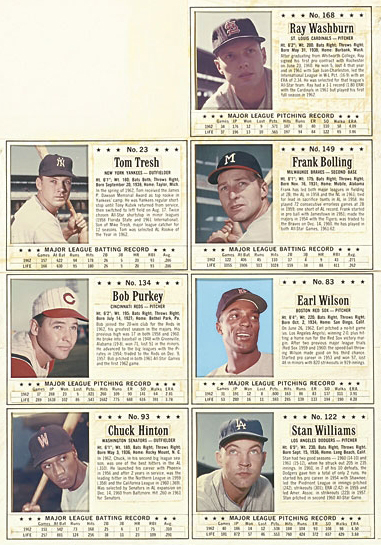 In order to create a cereal box back panel of cards, Post's art department created proportionally oversized production boards by pasting photos and biography information onto pieces of cardboard. The production boards were photographed and ultimately rotogravure cylinders were created to be used during the printing process. Most of the panels were printed on the back of only one cereal product, but there were five products matched with five other products that resulted in double printed back panels. The cards on the double print production board were photographed twice, once for each of the double printed panels. The ad header was changed, but the cropping of the cards remained the same for each of the double printed panels. The picture at right of a 1963 Post baseball panel may help illustrate what a production board looked like.
In order to create a cereal box back panel of cards, Post's art department created proportionally oversized production boards by pasting photos and biography information onto pieces of cardboard. The production boards were photographed and ultimately rotogravure cylinders were created to be used during the printing process. Most of the panels were printed on the back of only one cereal product, but there were five products matched with five other products that resulted in double printed back panels. The cards on the double print production board were photographed twice, once for each of the double printed panels. The ad header was changed, but the cropping of the cards remained the same for each of the double printed panels. The picture at right of a 1963 Post baseball panel may help illustrate what a production board looked like.
Alpha-Bits 8 oz. and Crispy Critters 8 oz.
Alpha-Bits 8 oz. box panels were double printed with Crispy Critters 8 oz. backs. Both are common border, six card panels. There were four different panels and 24 individual cards from each cereal. Crispy Critters box fronts and back panel headers were a shade of yellow that is slightly darker than the usual yellow color of the football with the card number in the upper right corner of each card. As a result, the football was also slightly darker, close to the color maize. Crispy Critters cards can be separated from their corresponding Alpha-Bits double prints by the shade of the football. There is a caveat here. The colors are best viewed in or near natural sunlight. Trying to view the cards under modern lighting will wash out the dark yellow color in the footballs and make it virtually impossible to tell them from each other. Similarly, scanners often have difficulty portraying the correct shade of the football making it difficult to identify online cards correctly. One more point about darker footballs is that Bran Flakes cards' footballs are slightly darker than most of the other cards. Again, this is due to the brown fronts and headers on the back tending to make the yellows darker. This being the case, it helps to know which cards were printed on Bran Flakes panels. In the case of cards such as #80 Dee Mackey, #87 Bill Pellington or #195 John Paluck which have both AB8, CC8 and BF11 cards, cropping and other color characteristics in the photo are key to identification.
As a general rule, most 8 oz. Alpha-Bits cards tend to have blue as the dominant color due to the fronts and headers using so much blue. This makes the grass often appear as blue-green and the sky tinted more intensely blue. With a lot of dark yellow or maize color on Crispy Critters boxes, the result is lighter, softer grass and sky. Again, this is a generalization. Ink intensity varies from card to card even within the same product. More discussion of ink intensity will follow on the "Wax, Ink, Borders" page.
Alpha-Bits 13 oz. and Crispy Critters 13 oz.
Crispy Critters 13 oz. panels were duplicates of 13 oz. Alpha-Bits backs. There are four panels of seven cards each for a total of 28 individual cards. While 8 oz. versions of Crispy Critters cards are somewhat difficult to find, 13 oz. Critters cards are truly rare. The 13 oz. cards are identifiable in the same manner as the 8 oz. cards—by the darker yellow football in the upper right corner of the card. For the most part, colors on CC13 cards are darker than their AB13 counterparts. The sky will likely be gray-blue, grass on the brown side and trees dark green. Uniforms on CC13 versions generally also have deeper colors. Ink intensity varies from card to card, so not every CC13 card will be as dark as another.
Sugar Coated Corn Flakes 10 oz. and Oat Flakes 15 oz.
The Post football promotion includes four panels from Sugar Coated Corn Flakes 10 oz. boxes with seven cards on each panel. Post's product list indicates they planned to double print all four SCCF10 panels on Oat Flakes 15 oz. boxes. As explained on other pages, Post ran a second production of only the two SCCF10 panels starting with card numbers 15 and 54, of which there are known examples of two distinct panels with consistently differing marks on the cards. These cards are considered as variations of the same card rather than distinct cards. For those interested in collecting the SCCF10 variations, the master set pages will show the differences between the cards.
There is no evidence that Oat Flakes 15 oz. cards or panels were ever sold in grocery stores.
Grape Nuts Flakes 12 oz. and Top 3 10 oz.
There are six panels of six cards of Grape Nuts Flakes 12 oz. and Top 3 10 oz. cards—36 cards of each product. These are the hardest double print cards to tell apart. The box front and back header of Grape Nuts Flakes boxes are light green while Top 3 fronts feature a blue bowl and a cheerleader boy with a red sweater and a red header on the back. The generalization drawn as to the difference in colors is that Grape Nuts Flakes cards are somewhat brighter, noticeable most in the sky and grass. Top 3 sky colors are typically lighter with a purple tint and the grass tends to exhibit a dull brown cast. Sometimes a player's hair color is darker on a Top 3 card. As with previous double prints, ink intensities can vary.
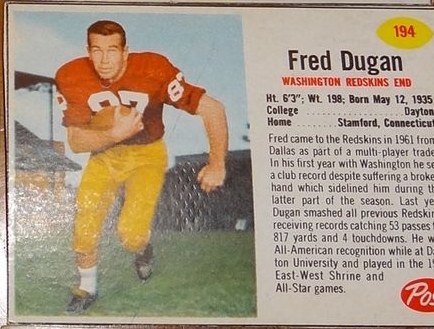 What Top 3 cards have on the bottom two-thirds of each panel that Grape Nuts Flakes cards do not is an imprinted pattern of small individual diamond shapes that resemble tire tracks. Evidently the Top 3 boxes were processed by machines that used some sort of roller either to laminate the paper to the cardboard or to help move the cardboard along during printing. In either case, the depth and width of the impressions is not always uniform, leaving some cards with wide patterns and others with only a few diamond shapes visible, other cards with easily seen patterns because of their depth and some barely visible at all. The patterns generally are recognizable only under a bright light while held at an angle. Scanners have little success picking up the patterns but occasionally a camera is able to capture the tire tracks. The #194 Top 3 shown here exhibits the tire track pattern under Fred Dugan's left arm.
What Top 3 cards have on the bottom two-thirds of each panel that Grape Nuts Flakes cards do not is an imprinted pattern of small individual diamond shapes that resemble tire tracks. Evidently the Top 3 boxes were processed by machines that used some sort of roller either to laminate the paper to the cardboard or to help move the cardboard along during printing. In either case, the depth and width of the impressions is not always uniform, leaving some cards with wide patterns and others with only a few diamond shapes visible, other cards with easily seen patterns because of their depth and some barely visible at all. The patterns generally are recognizable only under a bright light while held at an angle. Scanners have little success picking up the patterns but occasionally a camera is able to capture the tire tracks. The #194 Top 3 shown here exhibits the tire track pattern under Fred Dugan's left arm.
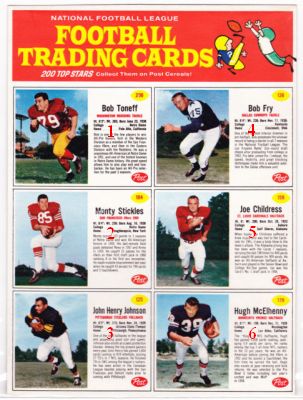 Top 3 panels show the tire track pattern only on the bottom four cards of the panel. If a pattern is visible on the middle two cards (cards 2 and 5) when numbered as shown here, you can know that these cards came from a Top 3 rather than a Grape Nuts Flakes panel. The same can be said for the card in the lower left (3rd) position. The card in the lower right (6th) position may or may not have the tire track pattern. While the pattern usually is fairly noticeable on lower left panel cards, often only a few very faint diamond shapes occur on the sixth position card if they are visible at all. The six lower right cards are #11 Jim Ringo, #31 Billy Ray Barnes, #90 John Unitas, #101 R.C. Owens, #120 Maury Youmans and #179 Hugh McElhenny. All six cards from the lower right position that have the pattern are known to exist. The two cards at the top in positions 1 and 4 don't have the pattern. It appears that the part of the machine that made these impressions during processing didn't touch the top two cards. All in all, 24 of the 36 Top 3 cards are known to have the tire track pattern.
Top 3 panels show the tire track pattern only on the bottom four cards of the panel. If a pattern is visible on the middle two cards (cards 2 and 5) when numbered as shown here, you can know that these cards came from a Top 3 rather than a Grape Nuts Flakes panel. The same can be said for the card in the lower left (3rd) position. The card in the lower right (6th) position may or may not have the tire track pattern. While the pattern usually is fairly noticeable on lower left panel cards, often only a few very faint diamond shapes occur on the sixth position card if they are visible at all. The six lower right cards are #11 Jim Ringo, #31 Billy Ray Barnes, #90 John Unitas, #101 R.C. Owens, #120 Maury Youmans and #179 Hugh McElhenny. All six cards from the lower right position that have the pattern are known to exist. The two cards at the top in positions 1 and 4 don't have the pattern. It appears that the part of the machine that made these impressions during processing didn't touch the top two cards. All in all, 24 of the 36 Top 3 cards are known to have the tire track pattern.
There are other ways involving marks or printing variations that identify Top 3 cards. Details for identification are shown on the master set page for that particular card.
There are some Rice Krinkles 10 oz. cards that display the same tire track pattern as Top 3 cards.
Post Toasties 12 oz. Top Flap and Post Toasties 12 oz. Flip-Out Spout
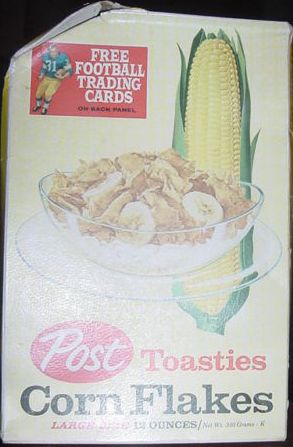
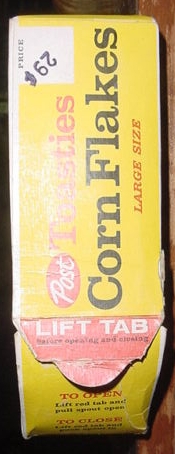 Post Toasties 12 oz. boxes were produced in two styles. The Post Toasties 12 oz. top flap version was a regular box with flaps that opened at the top like most cereal boxes. The flip-out spout box was a test version that utilized a tab that opened out of the upper corner and could be closed again after pouring the cereal. The pictures show how the box appeared from the front and top. Top flap boxes had a wax paper liner bag, but flip-out spout boxes had no liner at all. A liner would not have worked with the flip-out spout since it would have been very difficult to open and close before and after pouring. Instead, flip-out spout boxes had a special coating on the inside of the box giving the back of the cards a light color. Thus, flip-out spout cards have become known as "white back" cards.
Post Toasties 12 oz. boxes were produced in two styles. The Post Toasties 12 oz. top flap version was a regular box with flaps that opened at the top like most cereal boxes. The flip-out spout box was a test version that utilized a tab that opened out of the upper corner and could be closed again after pouring the cereal. The pictures show how the box appeared from the front and top. Top flap boxes had a wax paper liner bag, but flip-out spout boxes had no liner at all. A liner would not have worked with the flip-out spout since it would have been very difficult to open and close before and after pouring. Instead, flip-out spout boxes had a special coating on the inside of the box giving the back of the cards a light color. Thus, flip-out spout cards have become known as "white back" cards.
The 28 cards on the four panels of seven cards each are cropped exactly the same for both the top flap and flip-out spout versions. The easiest way to tell the two versions apart, of course, is to look at the back and see the lighter or darker cardboard. Not having the benefit of seeing the reverse side in most auction listings, a few generalities will help to some extent. PT12S cards are usually fuzzier than their PT12T brothers. This shouldn't be confused with a card being out of registration—which is when at least one of the four color layers used in the rotogravure process (cyan, magenta, yellow and black) is not lined up properly on the card and the result is that the photograph ends up with two or more images side by side making the picture severely out of focus. Fuzziness in PT12S cards is a softness that is somewhat akin to a watercolor painting. Flip-out spout cards, for the most part, have lighter colors. As with all Post cereal football cards, the generalization is not true in every case.

